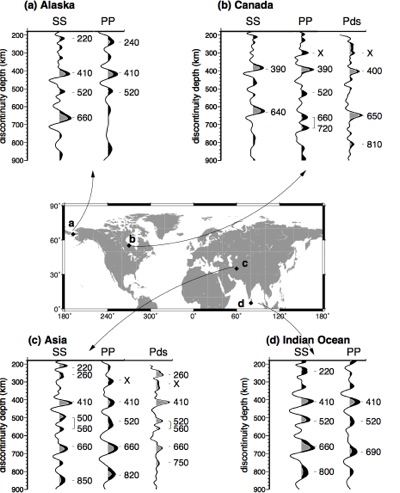Mantle Discontinuities
An important issue in seismology is the global and regional characteristics of velocity discontinuities in the Earth’s mantle. Some of these represent known phase transitions in mantle minerals. The existence and nature of such discontinuities is very important for our understanding of the internal dynamics of the Earth (such as mixing between the upper and lower mantle) and provides the input needed by mineral physicists to connect seismic discontinuities with mineralogical phase changes.

Examples of how seismic data can be used to study mantle discontinuities. Shown are traces for North America and Indonesia and a global overview of places where there are robust reflections from the Lehmann discontinuity. The dashed lines in the stacks represent the 95% confidence levels and the grey areas denote robust reflections. The Lehmann discontinuity at 220 km depth is present as a robust reflector below both Indonesia and North America. The 520 km discontinuity is split below Indonesia, but shows one peak under North America. There are also strong signals from lower mantle reflectors at ± 1100 km depth; these lie in a region in which recent tomographic models contain exceptionally strong high velocity abnomalies, (probably) associated with material subducted in the Indonesian subduction zone.
We have made the first global map of the Lehmann discontinuity at 220 km depth, and interpreted the observations as most probably being caused by a change in deformation mechanism. We also discovered that the mid-transition zone discontinuity at 520 km depth is ‘split’ in many regions and provided the first observations of the 660 km discontinuity using PP precursors. Previous studies had interpreted these discontinuities in terms of phase transitions in olivine. Our work, on the other hand, shows that additional phase transitions in garnet are needed to explain complex features seen in the seismic data. These results fundamentally change our ideas of how the mantle works and suggest that mantle mixing may vary regionally rather than being a globally unified process and that the Earth’s transition zone is more compositionally heterogeneous than previously thought.
Our aim is to build a global data set of many different data types that can be exploited to study mantle discontinuities and compared with new mineral physical results. During the last few years, we extended my original SS and PP precursor data set to receiver functions. More recently, we have been working on short period P’P’ precursors, which give puzzling results quite different from long period PP precursors, suggesting that the mineralogical properties of transition zone discontinuities may be frequency dependent. At the moment, we are focussing on two regional studies using receiver functions, one in Iceland to image the mantle plume and the other in Europe to study the regional subduction.
Reviews
- Deuss, A., Andrews, J., and Day, E. (2013). Seismic observations of mantle discontinuities and their mineralogical and dynamical interpretation, In Physics and Chemistry of the Deep Earth, S Karato (ed)., John Wiley & Sons , p297–323
- Deuss, A. (2009). Global Observations of Mantle Discontinuities Using SS and PP Precursors, Surveys In Geophysics 30(4-5) , p301–326
Publications
- van Stiphout, A. M., Cottaar, S., and Deuss, A. (2019). Receiver function mapping of mantle transition zone discontinuities beneath Alaska using scaled 3-D velocity corrections, Geophysical Journal International 219(2) , p1432–1446
- Jenkins, J., Maclennan, J., Green, R. G., Cottaar, S., Deuss, A. F., and White, R. S. (2018). Crustal Formation on a Spreading Ridge Above a Mantle Plume: Receiver Function Imaging of the Icelandic Crust, Journal of Geophysical Research: Solid Earth 123(6) , p5190–5208
- Jenkins, J., Deuss, A., and Cottaar, S. (2017). Converted phases from sharp 1000 km depth mid-mantle heterogeneity beneath Western Europe, Earth and Planetary Science Letters 459 , p196–207
- Jenkins, J., Cottaar, S., White, R. S., and Deuss, A. (2016). Depressed mantle discontinuities beneath Iceland: Evidence of a garnet controlled 660 km discontinuity?, Earth and Planetary Science Letters 433 , p159–168
- Cottaar, S. and Deuss, A. (2016). Large-scale mantle discontinuity topography beneath Europe: Signature of akimotoite in subducting slabs, Journal of Geophysical Research-Solid Earth 121(1) , p279–292
- Andrews, J. and Deuss, A. (2008). Detailed nature of the 660 km region of the mantle from global receiver function data, Journal of Geophysical Research-Solid Earth 113(B6), B06304
- Deuss, A. (2007). Seismic observations of transition-zone discontinuities beneath hotspot locations, In Plates, Plumes and Planetary Processes: Geological Society of America Special Paper 430, G R Foulger and , D M Jurdy (ed)., Geological Society of America , p121–136
- Deuss, A., Redfern, S., Chambers, K., and Woodhouse, J. (2006). The nature of the 660-kilometer discontinuity in Earth’s mantle from global seismic observations of PP precursors, Science 311(5758) , p198–201
- Chambers, K., Woodhouse, J., and Deuss, A. (2005). Topography of the 410-km discontinuity from PP and SS precursors, Earth and Planetary Science Letters 235(3-4) , p610–622
- Chambers, K., Deuss, A., and Woodhouse, J. (2005). Reflectivity of the 410-km discontinuity from PP and SS precursors, Journal of Geophysical Research-Solid Earth 110(B2), B02301
- Deuss, A. and Woodhouse, J. (2004). The nature of the Lehmann discontinuity from its seismological Clapeyron slopes, Earth and Planetary Science Letters 225(3-4) , p295–304
- Deuss, A. and Woodhouse, J. (2002). A systematic search for mantle discontinuities using SS-precursors, Geophysical Research Letters 29(8) , p90-1–90-4
- Deuss, A. and Woodhouse, J. H. (2001). Seismic observations of splitting of the mid-transition zone discontinuity in Earth’s mantle, Science 294(5541) , p354–357

